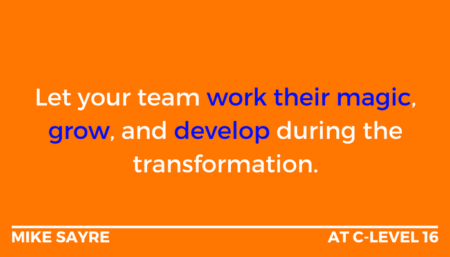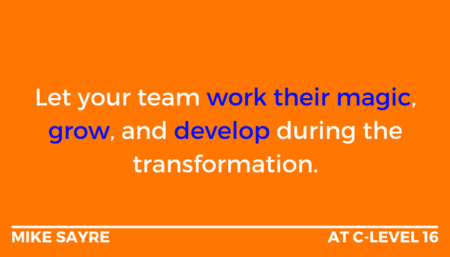At C-Level #16: Implementing Transformations and Measuring Success

Mike Sayre is a highly experienced and successful software, e-commerce, and manufacturing services CEO, COO, CFO, and Board Director. He is also the president & COO of Metcalf & Associates, a trusted partner inspiring and enabling perpetual innovation, evolution, and growth in leaders and their businesses. Mike was featured in Maureen Metcalf’s May 2017 Innovative Leaders Driving Thriving Organizations interview on VoiceAmerica entitled “7 Characteristics of Leadership 2020 In Practice: A CEO Story.”
In At C-Level #10-18, I write about three of the most successful transformations I’ve had the opportunity to lead in my career so far, following a seven-step transformation model like the Metcalf & Associates Innovative Leadership Transformation Model below.

Implement and Measure
Preliminary planning is communicated to the organization and transformation initiatives are ready to kick off. Those initiatives have metrics and goals for success that will naturally drive improvement in your overarching transformation metric(s), showing progress toward the mission and vision for the overall organization.
So, now it is time to start executing and your team is ready to go.
But, what about you? As a leader, your visibility, support, and participation are key to the implementation of these initiatives and how your transformation progresses. Your absence would show a lack of resolve and support for the transformation that YOU kicked off! I hope you’ve done some planning for this as well.
The level of your involvement will vary depending the needs of your team and the organization. Your vision, mission and values should drive a lot of decision making at the functional level, so you should not be needed to micro-manage the process. Let your team work their magic, grow, and develop during the transformation.
However, your visible support is critical. Be present, generally aware of happenings at the functional level, and, most importantly, be the main reporter of the major challenges and overall progress to the organization’s stakeholders on a regular basis.
Here is how we implemented and measured progress and achievement throughout the three transformations I outlined in At C-Level #10:
- Large Manufacturing Company. In our transformation to upgrade basic financial reporting controllers into true financial business partners in a large and growing company (our vision), we had two major initiatives:
- implementing new automated accounting and financial reporting systems, and
- creating a “controller-in-training” program to prepare up-and-coming and new controllers to be true financial business partners helping to grow the business.
To implement the new systems, we created a formal project team of current controllers serving as project managers and subject matter experts, accountants and clerical people with significant tenure in their jobs, and an internal auditor, using a well-known project management software. The make-up and experience in this team was key to the success of the initiative. The project re-energized team members who were ready to move on in their careers and were excited to contribute their company and functional expertise to making the implementation successful. They were among the most trusted professionals in the organization, maximizing the acceptance and the benefits of the new systems. The implementations were well managed, tracked, reported on, and successful, although they did take 30 to 40 percent longer to implement than originally expected. We opted for quality over speed – not an unusual tradeoff in these types of projects.
The controller-in-training program was modeled after comparable sales and operations training programs and consisted of potential controller candidates spending three months rotating through all the sales and operational departments in their facility, then spending three months in accounting and three months in activity-based costing and financial analysis roles. A team of senior financial people selected and hired the participants and I tracked their progress, but the facility people really made the training happen. About 25 percent of the participants landed their first controller jobs backfilling for turnover or being placed in the large new facilities the company was building at the time.
We were pretty good at implementing these projects and programs. However, I think we could’ve done better in terms of having more definition around what achievement of the vision would look like, as well as the metrics and goals that would validate our progress in transforming our controller group into “true financial business partners.” Our success on vision achievement would probably get mixed reviews depending on who you talked to in the organization.
In your own transformation journey, how will you measure ultimate success in achieving your mission and vision?
- Mid-Size Electronics Manufacturing Services Company. In our transformation “to be the best in the world at what we do,” and improve the lives all our five stakeholder groups, we had three major initiatives:
- implementing lean manufacturing,
- putting electronics repair operations in Europe and Asia, and
- developing and implementing a strategy to better leverage our engineering and manufacturing capabilities and earn higher margin work.
Having the right people in the right seats on the bus was key to our execution.
In a conversation with our quality manager about his wanting to leave the company, I discovered he was a Lean Manufacturing expert! He agreed to stay and took on the role of leading that initiative. We also hired an operations vice president with significant Lean experience. Their execution on the implementation, including ongoing measurement and reporting was incredible!
The executive team leveraged the work of our global sales manager in identifying the right acquisitions and partners for us to expand our operations in Europe and Asia.
We also implemented lean in our new facilities.
Not planned, but totally in line with our mission, our first Agile software development resulted in a company-wide repair tracking system across all our facilities and lauded by our global customers.
We hired a new sales vice president with an engineering background who had significant experience growing companies in the embedded computer industry, which leveraged our engineering talent and commanded the much higher margins we sought.
Everything we did had measurement and reporting systems, and our execution was great.
Did we achieve our vision? We decided early on that we would have to hear that directly from our stakeholders – the ones we named in our five-stakeholder mission statement.
Eventually, we did start hearing from them. You can read more about this in At C-Level #4.
Do you have the right people in the right seats on your bus? Is there any unknown or underutilized talent in your organization that could help lead your transformation?
- Global Internet Payments Company. In our transformation journey to turn around the culture, improve the operational and financial performance of the company, and increase the company’s value, we had three major initiatives:
- a company culture change driven by a stated mission and operating guidelines, and a change in leadership mindset, communications, and actions,
- the implementation of Agile software development in our company – which requires the involvement of all major functional areas of the company – and
- new strategy development and implementation in marketing and sales.
The culture change was all about leadership communications and “walking the talk.” See more about that execution in “At C-Level #15 – Transformation Communications.”
We measured culture change in the success of the Agile implementation. Agile requires so much cross-functional collaboration and communication that if the culture did not change, that implementation could not succeed.
We measured the success of the Agile implementation,
- quantitatively, by the 40 percent increase in our software development productivity, and
- qualitatively, by the increase in the usability and functionality of our product.
Our software was easier to use, looked more professional, helped our sales efforts, and benefited from the input of all the major functional groups in the company.
And, we measured marketing and sales success and the achievement of our mission to help sellers sell more by increases in customers and transaction volume.
But were we achieving our vision of increasing the value of the company for its owners? We were. The company realized a 300 percent increase in value through a major financial transaction within two years of the start of our transformation.
Do you have regular reporting and review cycles for all your initiatives and the achievement of your vision?
Key takeaways from these transformations
Discipline and focus are key, as is building repeatable processes that become a way of life.
Metrics and goals were either developed in planning or were built into the implementation processes of lean and Agile. Follow-up reporting, reviewing and analysis for progress and completion were part these processes as well. And where we did not use Agile or lean, we still had regular reporting and progress reviews.
There was so much going on in each transformation, I couldn’t manage it all…so I directed it and left the management to the functional experts and leaders on the team. I constantly and consistently pushed the vision and mission and lived our values to the best of my ability, trusting the team to give them life by making decisions that were similarly aligned. If they were not, we stopped, discussed them, and did the right thing. This is typical of Strategist or Level 5 leadership. See “At C-Level #9: Evolving Leadership for an Evolving World.”
To see more about the results of these transformations, please see my LinkedIn profile at www.linkedin.com/in/mikesayre.
In “At C-Level #17: Embedding Transformations,” we’ll look at what I’ve found to be the most challenging part of transformation work and the key takeaways that you may need to think about in your own organization’s transformative journey.
Thanks for following us! For more information or help, please visit us at www.Metcalf-Associates.com.





